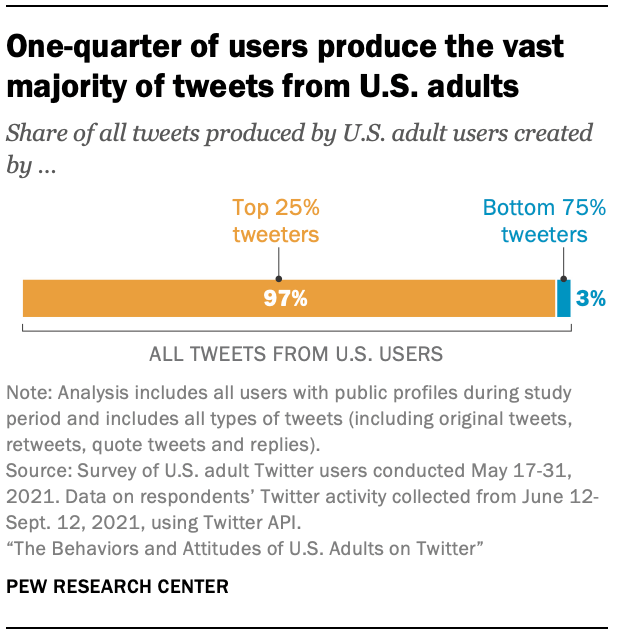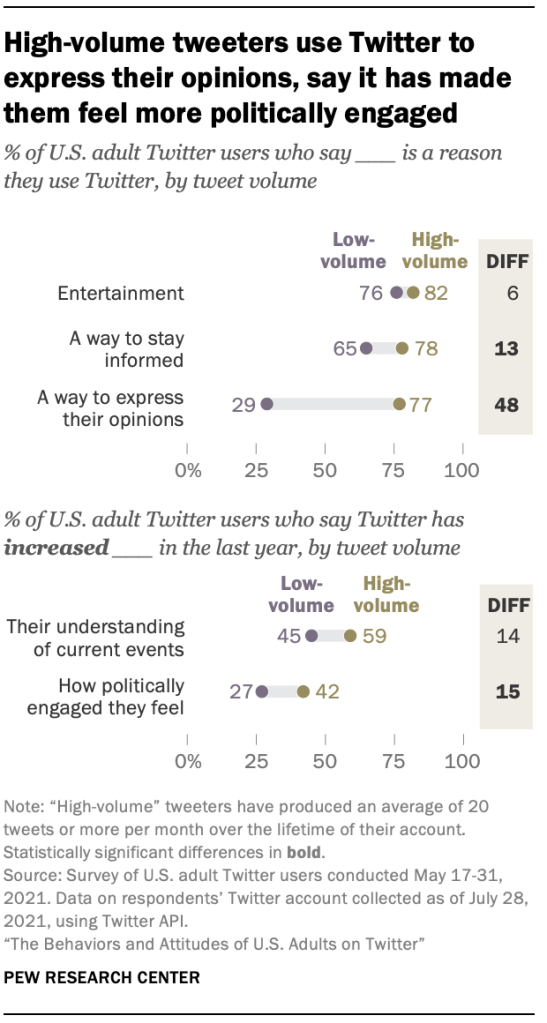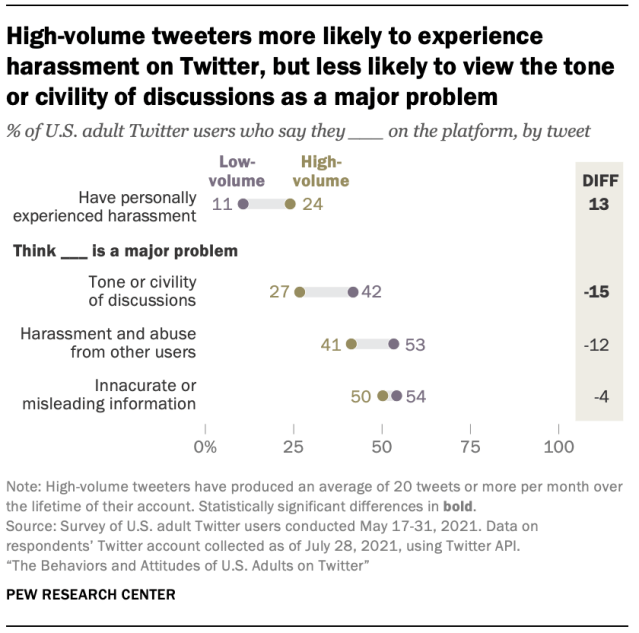In addition to surveying respondents who use Twitter about their experiences on the site, Pew Research Center also asked those Twitter users if they would be willing to share their handles for research purposes. In total, 1,026 respondents shared a valid Twitter handle. All of these accounts – regardless of their privacy settings – contained basic account metadata, such as the age of the account and total number of tweets during its existence.
Additionally, a subset of these accounts (n=917) were set to public – meaning their account activity was visible to anyone visiting their profile – over the time period of June 12 to Sept. 12, 2021. For these accounts, researchers were able to examine any tweets they might have posted in more granular detail over that time period and collect data about the content of the tweets themselves – such as how many likes and retweets each tweet received from other users.
A minority of users produce the majority of tweets from U.S. adults
As was true in the Center’s previous research on Twitter users, a minority of extremely active tweeters produced the overwhelming majority of all tweets made by U.S. adults between June 12 and Sept. 12, 2021. During this period, the top 25% of users by tweet volume produced 97% of all tweets (which includes original tweets as well as retweets, replies and quote tweets).
By definition, the most active tweeters produce far more tweets than other users – many of whom tweet infrequently, if ever. During the study period, this group produced a median of 65 tweets per month on average, compared with a median of no tweets per month from users in the bottom 75%. But these top tweeters also follow nearly four times as many accounts (469 vs. 125) and have substantially more followers (230 vs. 29) compared to the less active group.
Even so, these highly active tweeters typically receive modest engagement from the rest of the Twitter audience. In a typical month, the posts produced by high-volume tweeters would collectively receive an average of 37 likes and one retweet.
Although the top 25% of users produced the overwhelming majority of tweets within the study period, original tweets made up just 14% of their posts. By contrast, roughly 80% of tweets from this group are either direct retweets (49%) or replies to other tweets (33%). Replies and retweets similarly make up the majority of posts from less active tweeters as well.
Prolific tweeters differ substantially from other users in their self-described behaviors and attitudes toward the site
In addition to examining the on-site behaviors of users with public accounts over a three-month time period in 2021, the study also grouped users into high- and low-volume tweeter categories based on all users (those with public and private accounts alike) and the number of tweets they have produced over the life of their accounts. For the analysis that follows, high- and low-volume tweeters are defined based on this metric. High-volume tweeters are those who have produced 20 or more tweets per month over the life of their account, while low-volume tweeters have produced fewer than 20 tweets per month on average. 1
High- and low-volume tweeters tend to look relatively similar in terms of their basic demographic and attitudinal characteristics. Age is the primary distinguishing characteristic between these two groups. Twitter users in general tend to be younger and contain a larger share of Democrats and Democratic-leaning independents relative to nonusers. Among U.S. adults who use Twitter, high-volume tweeters tend to contain a larger share of 18- to 29-year-olds (44% are in this age group, compared with 20% of low-volume tweeters) and a lower share of those ages 30 to 49 (28% vs. 54%).
High-volume tweeters also tend to be much more intensive users of the site in general. They are roughly twice as likely to say they use the platform every day compared with their less prolific counterparts (58% vs 28% of low-volume tweeters). And around one-in-five (21%) say they access Twitter “too many times to count” in a day.
Echoing the findings in Chapter 1, a majority of U.S. adults who provided a valid Twitter handle say entertainment (78%) and staying informed (69%) are reasons why they use the site, while just under half (45%) say they use the platform as a way to express their opinion. High-volume tweeters are much more likely say they use Twitter to express their opinions: 77% of them do so, compared with 29% of lower-volume users.
Even so, only around one-in-five (17%) of these highly prolific tweeters say that expressing their opinion is their main reason for using the site. An identical share (17%) say they are primarily motivated by a desire to stay informed, while 47% say they are primarily motivated by entertainment.
Some 42% of high-volume tweeters say that Twitter has made them feel more politically engaged in the last year, significantly larger than the share of less prolific tweeters who say the same (27%). And about six-in-ten say the platform has increased their understanding of current events.
Meanwhile, high-volume tweeters are roughly twice as likely as other users to say they have personally experienced online harassment or abuse while on the site (24% vs. 11%). But they are less likely to view the tone or civility of discussions on the site as a major problem when compared with low-volume tweeters. By contrast, nearly identical shares of high- and low-volume tweeters feel that inaccurate and misleading information is a major problem on the site.
Many users are unsure or incorrect about their Twitter privacy settings
Among all U.S. adults on Twitter, roughly half say that their Twitter account is set to public so that anyone can see their tweets. Another 29% say it is set to private so only people who follow them can see their tweets, and 17% say they’re not sure what their privacy settings are. Among users who volunteered their profiles for research purposes, 65% say their account is public, 19% say their account is private and the remaining 17% say they’re not sure.
But in actuality, a direct examination of the privacy settings of these users’ accounts reveals that the vast majority (89%) of U.S. adults on Twitter have public accounts that are visible to anyone visiting the site. Put differently, 83% of Twitter users who say their accounts are private or who are not sure of their privacy settings actually have public accounts.






